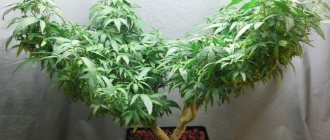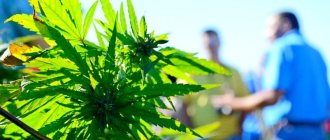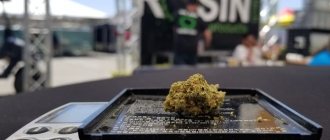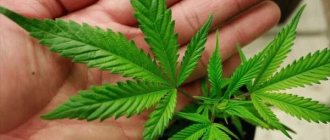Growing your own marijuana can be a fun and rewarding experience. However, circumstances may turn out to be unfavorable and you will be disappointed and your money will be wasted. For a new grower with limited resources, growing indoors can be prohibitively expensive. But the good news is that a small outdoor garden can produce a large harvest of quality cannabis without a big investment. If you have access to a sunny spot in your private yard or on your balcony, deck, or rooftop, you can successfully grow cannabis. In our guide to growing outdoors, we'll look at factors to consider when setting up your first outdoor grow.
Problems arising in open ground (pests, mold, etc.)
When growing plants outside, you need to always be on guard and keep an eye on the bushes all the time! After all, if you fence them with a fence or wire, it may attract someone's attention. The use of chemicals against pests is also not acceptable, since they will harm the plant, making it unsuitable or even harmful to use.
When you just plant a small plant outside, rabbits, mice, gophers and other animals are drawn to it like a magnet. Some gardeners recommend using your own urine to scare away animals by pouring it around the bush. You can use predator urine if you can get it somewhere. Its smell will repel both small and large animals. It is also recommended to use human hair wrapped in tights or some kind of fabric. In general, the smell of a person, various perfumes, often scare away many animals. You can cut the soap into shavings and scatter it around. However, due to rains, this operation will need to be repeated several times during the season.
Well, against slugs, you can use copper wire, placing it around the perimeter, around the bushes.
However, the worst problem may be mold.
To prevent mold from appearing on the plant, you need to improve air circulation. To do this, you need to tie up the lower branches, lowering them lower so that air circulates well between them and the rays of the sun fall. This will not only help avoid mold, but will also ensure a larger harvest due to good lighting.
But, be careful with the branch stretching method! Be careful not to break them accidentally. To prevent this from happening, do everything slowly and gradually. You should not stretch all the branches at the same time. When the branches stretch, an empty space will temporarily form between them, which will very quickly be overgrown with new branches. This method can be compared with the ScrOG method, but without cutting off the tops, you form the bush by stretching.
Well, if mold does appear on the plant, try to cut it off the bush as quickly as possible. Mold spreads very quickly. It’s better to play it safe and get rid of an entire branch than to endanger the entire bush. After removing the mold, carefully monitor the bush so that it does not appear anywhere else.
In addition to all of the above, hemp can be threatened by many other things. For example, various insects or humans. In addition, unfavorable natural conditions can destroy the plant. If the weather is too cold or, conversely, too hot, there will be a lack of water. All these factors need to be taken into account. After all, hemp loves moisture. And carrying water several kilometers every couple of days is quite expensive. Especially if you planted a lot of plants. It would be better if there was a body of water nearby. This will make the task much easier.
Watering during the vegetative stage
The frequency of watering a plant depends on its water consumption, as well as the temperature and humidity in the grow box. Most often, the plant needs water every 2-3 days. Also, you need to take care of adequate drainage by making a sufficient number of holes in the bottom and walls of the pot, or simply buy a fabric pot (smart-pot) or air-pot. You can read a separate article on how to choose a pot for growing marijuana.
Watering scheme for growing in the ground:
- Check the moisture content of the top layer of soil by plunging your finger into it to the depth of one khalange. The plant needs watering only when the top few centimeters are completely dry.
- Add fertilizer (if you are using it) to the water and measure the final pH. It should be in the range of 6.0 - 7.0.
- Water your cannabis with an amount of water that corresponds to approximately 20%-30% of the pot's volume (over time, you will find the amount of water your plant needs). In this case, about 20% of the water should come out of the drainage holes immediately after watering.
If water takes too long to drain from the holes, or the soil doesn't dry out for more than 5 days, you may have drainage problems.
When growing in coir and other soilless mixtures, the watering schedule is slightly different. Many hemp growers make the mistake of treating coconut fiber as soil. Watering coir is more similar to hydroponic growing. Cannabis growing in coconut fiber is almost impossible to overwater. Moreover, you should not wait until the fiber is completely dry.
If it is possible to weigh the pot, then this can be a great way to determine the exact moment to water. Record the approximate dry weight of the pot with the plant, then water it and weigh it again. Don't forget that cannabis gains weight.
We recommend watering the coconut plant daily.
A separate article about watering marijuana.
Additional Tips
- Never go to your plantations without mosquito repellent. Just remember this.
- If you do not have the opportunity to regularly visit the plantation, you can cut off the neck of a 5-6 liter bottle, make several holes the diameter of a pencil in the lower part of the side walls, and bury the bottle next to the marijuana so that all the holes are underground. Such a primitive drip irrigation system will allow the plant to last longer without regular watering.
- Having decided on the location of the plantation, take an hour or two of your time and carefully check the area around. A male bush of wild hemp growing nearby can inadvertently fertilize your girls, reducing all the efforts of the grower to nothing, because female unfertilized individuals (sensimillas) are most suitable for consumption.
- If you had to clear any clearing of vegetation to plant cannabis, do not rush to throw away the vegetation that was previously living there. Scatter it around your planting area. This will help hide the black pieces of freshly dug soil that you will leave behind after planting. In addition, with a sufficient amount of mowed vegetation, a good organic mulch can be obtained.
- There is an interesting method for increasing marijuana yields called “rolling.” The essence of the method is to wrap the roots and stem of the plant at an early stage, while they are amenable to physical influence.
The result of the "twist"It is best to twist marijuana during transplantation of a 10-12 day old plant, when it consists of only a stem and one inflorescence. If you plan to plant your cannabis outdoors until after puberty, replant at home. Sprout a marijuana seed in a disposable plastic cup, then transplant it into a large half-liter glass or other container, twisting the sprout. The essence of twisting is to turn the stem of the plant clockwise, gradually covering it with soil. By leaving only the inflorescence above the ground, you turn the plant stem into a new, powerful root, which abundantly nourishes the plant and allows it to grow at an accelerated pace. This procedure increases the potential size of the plant and yield, making the cannabis bushier and healthier.
- Never leave trash such as cigarette butts, beer bottles and packets of chips in your plantation. This way you will not only thank Mother Nature for your harvest, but you will also not attract unnecessary human attention to your meadow.
- If you plant cannabis immediately after germination, the bush will enter the vegetative stage, beginning its development. If the transition to outdoors occurred after the appearance of sexual characteristics, then your plant will begin preparing for flowering immediately after adaptation (1-2 weeks). To become familiar with the vegetative stage of marijuana outdoors, as well as the flowering stage, you can read the rest of the articles in our outdoor section.
Choosing an outdoor location and preparing the land
The second important stage is choosing a location. Here it is worth considering several factors: the illumination of the place, its accessibility, proximity to residential buildings and busy highways. For light-loving plants, it is better to choose an open place where sunlight reaches most of the day. The south side is perfect for this. Another trick is to plant plants in lowlands, so they will be protected from the cold in case of frost.
The soil in the selected area will rarely be good, so it is best to prepare it. Or in the fall, by digging up an area with fertilizers and humus (vermicompost). Or, just before planting, dig a hole and fill it with purchased soil mixed with coconut, perlite and vermiculite. When replanting a plant in a grow bag, there is no need to manipulate the substrate; root feeding will be sufficient. The bag will protect the root system of the seedling from pests living in the soil; even moles will find it difficult to dig under.
Nutrition and fertilizers
In open ground, watering will be required mainly at the stage of transplanting seedlings or during drought. Once the plant is established, it will have enough moisture from the soil. But don't forget about root feeding. It is rare to find a suitable area, and even close to a water source, so it is more convenient to use dry fertilizers. They are mixed with the soil and the nutrients, gradually dissolving, will enter the plant. Similar dry fertilizers include PowderFeeding from Green House, Valagro and HB-101. To increase the efficiency of plant absorption of nutrients from the soil, you can enrich the soil with beneficial microorganisms, for example, by adding vermicompost.
Plants need to be fed during transplantation and during flowering. And the better you feed them at the flowering stage, the greater results you will achieve. Watering (feeding) should be done early in the morning or after sunset. After all, in the midday heat, the water will evaporate without having time to seep into the soil.
Hemp cultivation technology
Hemp occupies a prominent place among industrial crops. Its fiber is indispensable in the manufacture of sea and river ropes, as it has high strength and the ability to slowly rot when left in water for a long time. A significant part of the hemp is used to make ropes, twine, canvas, tarpaulin, and tow.
Hemp seeds contain 20-23% protein and 20-35% high-quality vegetable oil, which is used in the canning and confectionery industries, as well as soap making and for the production of drying oils and paints. The cake serves as valuable feed for livestock. The fire is used to make building boards, paper and plastics.
The distribution areas of hemp are the Central Black Earth region, the Volga region and the North Caucasus.
1. Place in crop rotation.
Hemp grows well on alluvial, floodplain, cultivated, humus-rich soils and drained peat bogs after 2-3 years of cultivation of other plants on them, with a neutral or slightly alkaline reaction, light or medium in granulometric composition. If the farm does not have low-lying lands, the crop is sown on lands of normal terrain.
In crop rotations, hemp should be placed after winter wheat, legumes, spring grains, potatoes and root crops. It is advisable not to sow it on corn and again on hemp. This contributes to the accumulation and spread of common pests and reduced yield. It is allowed to sow hemp over sunflower, sudanese and in areas infested with rhizomatous weeds. Broomrape causes serious damage when re-seeding hemp.
Hemp, as a row crop, cleans the soil well of weeds and serves as a good precursor for spring grains and annual grasses.
2. Basic tillage.
The root system of hemp is poorly developed. The bulk of active roots on light soils develop in a layer of 40 cm, and the main root can penetrate up to 2 m. On peat and marshy soils, the depth of penetration of the main root is 40-50 cm, and the roots spread to the sides by 10-20 cm. Due to Therefore, it is important to create optimal conditions for the development of roots and plant nutrition.
Basic tillage consists of:
1) treatment with disc implements at a depth of 6-8 cm after harvesting the stubble predecessor or after potatoes and root crops, if the field is weedy. Depending on the type of clogging, the 2nd treatment can be carried out using frame hoeing machines or flat-cutting cultivators (T-150+PPL-10-25, MTZ-80/82+PPL-5-25 or K-700A(701)+KPSh-10, T- 150+KPSh-5) by 10-12 cm.
2) deep autumn plowing at 25-27 cm, if the arable horizon allows, 10-15 days after peeling. Hemp responds well to deepening the arable layer. If necessary (in arid conditions, if the soils are subject to water or wind erosion), plowing can be done by flat-cutting deep-ripper cultivators (T-150+KPG-250A) or flat-cutting deep-rippers (K-700A+PG-3-5, T-150 +PG-3-100).
Spring tillage begins with harrowing with heavy toothed harrows at an angle or across to plowing in a unit with trains. Next, depending on the degree of soil contamination, we carry out 1-2 cultivations. The first one is carried out 8-12 days after harrowing at 6-8 cm. The last one is carried out to the depth of seeding immediately before sowing.
3. Fertilizer system.
Since hemp has an underdeveloped root system, it can grow well only with sufficient nutrients and readily available moisture. It responds well to the application of organic and mineral fertilizers.
One of the peculiarities of cannabis biology is uneven growth. The most intensive growth and active nutrition is observed during the period from the beginning of budding to full flowering at the end. It has been established that for 1 centner of dry weight of the crop of Central Russian hemp plants of bilateral use there are 1.5-2 kg of nitrogen, 0.5-0.6 kg of phosphorus and 0.7-1.2 kg of potassium. Hemp is superior to grain crops, flax, and root crops in removing nutrients from the soil.
Hemp receives the greatest effect from the use of fertilizers when they are applied in fractions (under the main treatment of NPK 60 , in the spring before or during sowing and in fertilizing). An increase in yield is obtained by using granulated superphosphate when sowing 10-15 kg/ha a.i. Among organic fertilizers, peat, slurry and bird droppings are effective. Peat soils require the application of copper-containing fertilizers, as well as magnesium-boron waste (20-25 kg/ha). Mineral fertilizers can be applied using various machines, for example: RMG-4, MVU-0.5A, NRU-0.5A, Amazone ZAM-900, etc.
An effective and environmentally friendly way to provide the soil with organic matter and plants with nutrients is the use of green manure. As green manure crops, vetch, mustard, sweet clover, sainfoin, and oilseed radish are used, which are capable of steadily accumulating large biomass in a short growing season and are undemanding to the level of soil fertility.
4. Preparing seeds for sowing.
Since seeds intended for sowing must be brought to the standard, it is necessary to test the sowing qualities of prepared seeds in laboratory conditions. From every 10 tons of a batch, 1 average sample weighing 500 grams is taken. Based on the results of seed testing, analysis results or a test report are issued. According to the current standard GOST R 52325-2005, monoecious hemp seeds must have the following sowing qualities:
| Index | Seed category | |||
| OS | ES | RS | RSt | |
| Varietal purity, %, not less | 99,5 | 99,0 | 95,0 | 90,0 |
| Contents of other plant seeds only 1 kg, pcs., no more | 75 | 75 | 150 | 200 |
| incl. weed seeds, pcs., no more | 50 | 50 | 100 | 150 |
| Germination rate, %, not less | 90 | 90 | 80 | 70 |
| Humidity, %, no more | 13 | 13 | 13 | 13 |
OS, ES and RS seeds containing the quarantine weed broomrape, as well as hemp leaf roller and its larvae are not allowed for sowing.
According to the Decree of the Government of the Russian Federation of July 20, 2007 No. 460, it is prohibited to use hemp seeds of the 4th and subsequent reproductions for sowing for industrial purposes. Certified seeds of zoned varieties of appropriate reproductions must be used for sowing.
To neutralize a possible seed infection, as well as to prevent diseases of seedlings and seedlings, it is necessary to first treat the seed material with one of the following preparations (l/t): tebu (0.4-0.5), bunker (0.4-0.5), armor (0.4-0.5), raksil ultra (0.25), TMTD (3-5), vincit (1.5-2), raxon (0.5). When treating seeds, the use of Albit together with fungicides is effective. This drug combines fungicidal properties and the function of a growth stimulator. Dressing reduces the prevalence of root rot by 1.5 times. For etching, PS-10, Mobitox (wet etching) and PSSh-3 (semi-dry etching) machines are used.
Hemp is demanding on growing conditions. In the early period of growth, it is less demanding of heat than other crops. However, cool weather (+10…+12℃) in the first 30-40 days retards growth and negatively affects the future harvest. Seeds can germinate at temperatures of +1…+2℃. The optimal temperature for germination is +25…+30℃. Seedlings can tolerate frosts of -3… -6℃.
Sow hemp in soil heated to +9…+10℃. When scheduling sowing dates, it is necessary to ensure that seedlings do not appear during the period of possible return of frost. At low temperatures, when the soil is not yet warmed up enough, the seeds can lie in damp soil for a long time, losing their germination capacity, and some may rot. If sowing is too early, the seedlings appear unfriendly and weak, as a result of which they are severely suppressed by weeds. Delays in sowing hemp, especially in years with a dry spring, also lead to sparse seedlings. The optimal sowing time in the forest-steppe zone of the Middle Volga region is the 3rd ten days of April - the 1st ten days of May, and in floodplain areas - as the soil matures.
Depending on the purpose of cultivation, hemp is sown in various ways, for example, using a 2-line tape method (60x15). When cultivating Central Russian hemp for fiber and seeds and southern hemp for greens, the row sowing method (13-15 cm) and narrow-row (7.5 cm) methods are used, when cultivating for seeds - wide-row (70 cm). For better illumination, the rows are positioned from north to south.
The seed sowing rate is determined by the sowing method, the purpose of cultivation, etc. Increasing the seeding rate increases stem yield but reduces seed yield. Thickened crops provide higher yield and better fiber quality. The optimal sowing rate of hemp seeds for green grass in southern latitudes is 70 kg/ha (approximately 4 million germinating seeds). For seed crops, a seeding rate of up to 20 kg/ha can be recommended. In the northern regions, with a double culture of Central Russian dioecious hemp, 6-7 million viable seeds/ha (100-120 kg/ha) are sown. In the middle zone, 80-85 kg/ha is recommended for monoecious hemp. New varieties of monoecious hemp have been developed that provide for lower seed sowing rates, for example the Vera variety - 3 million seedlings. seeds/ha when sowing for greens and 0.6 when cultivating for seeds. For the Diana variety - 1.8-2.7 million - for greens, for super-elite and elite for seeds - 0.9-1.5 million, for the 1st and 2nd reproductions - 1.8-2.7 million germinated seeds/ha.
The seeding depth is on average 3-4 cm, on wet heavy soils 2-3 cm, and on light sandy loam up to 5-6 cm.
5. Care of crops.
To obtain uniform shoots, the crops should be rolled with ring rollers. If a soil crust forms, pre-emergence harrowing is carried out, which also destroys weed seedlings.
During the first growing season, hemp grows slowly, and if inter-row cultivation is delayed, weeds can choke out the crops. The first inter-row treatment is carried out at 4-6 cm immediately after the rows are designated. The second and subsequent treatments are carried out as weeds appear and the soil compacts after heavy rains to a depth of 8-10 cm.
During the full flowering phase of plants, artificial pollination of hemp is necessary. This event, carried out in the morning, contributes to better pollination and an increase in seed yield by 12-15%.
During the growing season, hemp can be damaged by pests and diseases.
The main pests of hemp are: hemp flea, aphids, leaf rollers, stem borer. To combat them, you need to use the following drugs (l/ha): diazinon (1.7), rebound (1.7), ditox (1.2-2), di-68 (1.2-2), bi- 58 new (1.2-2), danadim (1.2-1.9), super samurai (1-1.5), zolon (1.5-3).
The main diseases are: fusarium, spotting and stem rot. The crops can be treated with various sprayers, for example: OPSH-15, POU-630, Delvano, Amazone in combination with MTZ-80/82.
6. Cleaning and processing of seeds.
The amount of stem stem in general is 48-50% and it ripens 40-45 days earlier than the mother. Therefore, the most part is harvested earlier, by manual sampling when using double-sided crops. Standing too long makes it difficult for mechanized harvesting of the residual mass and reduces the amount of fiber from the mat. Harvesting begins at the full flowering stage and is harvested within 10-12 days. The mother material is removed when the seeds ripen in the middle part of the inflorescences. Delay leads to large losses during harvesting. Harvesting in the phase of full ripening leads to a loss of 15-20% of the crop, overstaying 10 days after full ripening provokes losses of up to 40-50%, 20 days overstaying causes a crop shortfall of 75-85%.
Non-simultaneous maturation of seeds complicates the technological process of harvesting, which indicates the need for pre-harvest drying of the seeds with desiccants. For this purpose, you can use Reglon super (1 l/ha) when 50% of the seeds are ripe. Cleaning can begin after 7-10 days. The drug effectively dries the mats and reduces the moisture content of the seeds by 3-5%. Proper desiccation improves the quality of threshing, significantly reduces losses and does not affect the yield and seed quality.
When cultivating hemp for greenery, the highest fiber yield is obtained when harvesting in the late flowering phase. The cutting height should not exceed 6-8 cm.
Post-harvest processing of hemp seeds includes preliminary cleaning, drying and sorting. The most suitable machines for pre-cleaning are OSV-10, OVS-25, VS-10. For final cleaning - OSM-3U, OS-4.5A, Petkus Gigant. To separate large impurities from a grain heap, the top sieves are installed with round holes from 5 mm, and to remove small impurities, underseeding sieves with oblong holes 1.7-2.2 mm wide, middle sorting sieves are installed with round and oblong holes 2.6 mm wide -3.0 mm. If there are impurities in the processed material that cannot be separated by air flow and sieves, a trier group of grain cleaning machines is turned on.
You can purchase high-quality certified seeds of industrial hemp, as well as other oilseeds and cereal crops in our.
Current information with prices for seeds and their availability is presented on our official website in the “Price List” section .
A boat is sailing on the river
Arkhangelsk drug dealers, detained a few days ago, took a thorough approach to cultivating drug crops. The boat, where the seedlings and plants were located, had modern irrigation equipment, powerful lighting lamps, and fertilizers.
“Three previously convicted local residents aged 43 to 54 were detained and are suspected of illegally cultivating drug-containing plants,” explained the official representative of the Ministry of Internal Affairs, Irina Volk. The department's statement says that in order to detain the suspects, the Grom special forces had to board the ship.
handcuffs
Photo: IZVESTIA/Mikhail Tereshchenko
The salt: new types of drugs have attracted all groups of the population
The drug situation in the country is a state of a compressed spring
According to Izvestia’s interlocutor in law enforcement agencies, the cultivation of drug-containing crops in hard-to-reach regions is especially beneficial for the drug business. In other words, where the logistics of foreign drug dealers do not reach, we are largely talking about the traffic of cannabinoids from the territory of Ukraine, Moldova, Morocco (via Spain). Therefore, most often Russian law enforcement officers find plantations in Central Russia, the Volga region, Siberia, and the Far East.










